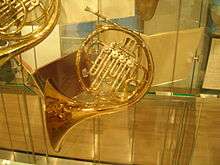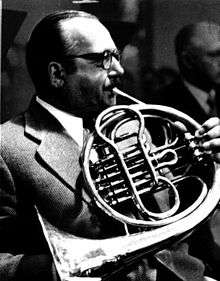Horn Concerto No. 2 (Strauss)
| Zweites Konzert in Es-dur für Horn und Orchester | |
|---|---|
| Horn concerto by Richard Strauss | |
 Dennis Brain's horn | |
| English | Second concerto in E-flat major for horn and orchestra |
| Key | E-flat major |
| Catalogue | TrV 283 |
| Composed | Completed 28 November 1942 |
| Dedication | To the memory of my father |
| Scoring | Chamber orchestra. |
Richard Strauss composed his Horn Concerto No. 2 in E-flat major, (TrV 283) whilst living in Vienna in 1942. The work was premiered in 1943 at the Salzburg Festival and recorded in 1944, both with solo horn Gottfried von Freiburg. The score was published by Boosey and Hawkes of London in 1950. It was taken up and popularised by the British horn player Dennis Brain. It has since become the most performed and recorded horn concerto of the 20th century.
Composition history
The premiere of Strauss's opera Capriccio was on 28 October 1942. Strauss wrote "My life's work has been concluded with Cappriccio. Whatever notes I scribble down now have no bearing on musical history."[1] A couple of days later he drove to Vienna where he was to stay for over 6 months.[2] The horn concerto seems to have been written very quickly: his note book indicates that the draft was finished on 11 November, and the final score two weeks later on the 28th (he added a note at the end "In the beautiful house at Vienna"). The autograph score indicates that it is dedicated "To the memory of my father", although this did not make it into the published version. The speed of composition may reflect it had been on his mind for sometime, as the principal horn player at Munich, Professor Josef Suttner, had asked him years before to write a second concerto.[3] Strauss also mentioned the second concerto in a program list written in 1941.[4][5]
Since he had finished An Alpine Symphony in 1915 until 1942, Strauss had devoted himself almost completely to operatic works, with no substantial orchestral works. The few works from this period include the ballet Schlagobers (1922), the two Couperin Suites (the 1923 Dance suite and the 1941 Divertimento) and Japanese Festival Music (1940). The Second Horn Concerto was the first in a series of late works often referred to as his Indian summer, which include Metamorphosen, his Oboe Concerto, the Duet concertino for clarinet and bassoon, ending with his most famous and popular work Four Last Songs written just before his death in 1949. He gave no opus number to any of these late works and none were published during his lifetime.
The Strauss family were not in a good place in late 1942. His wife Pauline had developed problems with her sight, whilst Richard developed serious influenza.[6] The safety of his Jewish daughter-in-law Alice and grandchildren remained precarious: part of the reason for staying in Vienna was the protection provided by the Nazi governor of Vienna, Baldur von Schirach, who was a great admirer of Strauss and his music. The mass deportations of Jews started in 1941. In the summer of 1942 Strauss had become involved in the unsuccessful attempts of his son Franz and Alice to help her relatives emigrate to Switzerland. Strauss himself visited Theresienstadt concentration camp where he greeted the SS guards with the words "I am the composer Richard Strauss" and was duly sent away without being able to see Alice's relatives who were incarcerated there (26 of Alice's Jewish relatives were to die before the end of the war).[7] Norman Del Mar wrote in 1972: "It is indeed hard to believe that this is the work of a depressed old man living in fear of disgrace from the authorities of a war-beleaguered country, so light and carefree a style did he capture"[8] Clearly, composing provided an escape from the uncertainty and horrors unfolding around him. It also reflected his aesthetic that art and Culture were the highest human achievement that transcended history. In 1900 he had set Uhland's song "Des Dichters Abendgang" (The poets evening stroll), which expressed this view that "When the dark clouds roll down..You carry within yourself the blessing of song. The light, that you saw there, Gently shines upon you on the dark paths."
Performance history

The premier was given at the Salzburg Festival on 11 August 1943 with the horn player Gottfried von Freiberg (1908–1962), Karl Böhm conducting the Vienna Philharmonic.[9] The same combination recorded it soon after. Richard Strauss himself was not present at the premiere, but had been at the festival earlier and left on 9 August after conducting some all Mozart concerts to return home to Garmisch. He had, however, worked with Böhm and Gottfried during his stay: the signed autograph manuscript used for the premiere is dated August 8. The concerto was played a second time on 26 May 1944, with the horn played by Max Zimolong and Karl Elmendorff conducting the Staatskapelle Dresden.[10] British Horn player Dennis Brain performed it with the Vienna Philharmonic in 1948, later recording it with the Philharmonia Orchestra conducted by Wolfgang Sawallisch. The US premiere was given on 8 October 1948 with soloist Anthony Miranda and the Little Orchestra of New York conducted by Thomas Sherman, and a year later at the Tanglewood with James Stagliano on horn and the Boston Symphony Orchestra conducted by Eleazar de Carvalho. The concerto went on to become the most performed of 20th-century horn concertos (it was performed twice in the finals of the BBC Young Musician competition, in 1988 by the winner David Pyatt and in 2016 by runner up Ben Goldscheider).
Structure
The concerto is written in a conservative style that looks back to the musical world of his teenage years as represented by his First Horn concerto completed in 1883. Strauss follows the classical concerto structure of three movements with a rondo finale, with the three movements in E flat, A flat, E Flat.
- Allegro
- Andante con moto
- Rondo. Allegro molto
Juergen May writes:
Still, there are "Straussian" melodic shapes, harmonic successions, and rhythmic characteristics that reveal the identity of their creator. The composer looks back to a past aesthetic from the perspective of someone who has lived through the paradigm changes of the nineteenth and twentieth centuries. In that respect, one might call the work postmodern.[11]
Norman Del Mar wrote that "...the piece had turned into a singular success from first to last. It is the freedom and originality of form, especially in the opening allegro which reveals the experienced master as compared to the first concerto". Whilst the outer movements are virtuosic, the middle movement is a "beautifully proportioned miniature and particularly well conceived as a relaxation for the soloist between the exacting outer movements."[12]
Recordings
There have been many recordings of this piece. The first generally released recording was by Dennis Brain in 1957, with the Philharmonia Orchestra conducted by Wolfgang Sawallisch. However, the 1944 world premier recording has recently become available. Those currently available with orchestral accompaniment include:
| CD title and release date (if known) | Horn player | Orchestra and conductor | Label and reference |
|---|---|---|---|
| Mozart: Serenade No. 13 in G major, K525 'Eine kleine Nachtmusik', etc. | Gottfried von Freiberg | Vienna Philharmonic, Karl Bohm | Orfeo - C376941B |
| Dennis Brain: The essential collection Vol.5 (2014) | Dennis Brain | Philharmonia Orchestra, Wolfgang Sawallisch | Documents 299708 |
| Zdeněk Tylšar: Richard Strauss / Franz Strauss / Mozart: Horn Concertos (2006) | Zdeněk Tylšar | Czech Philharmonic Orchestra, Václav Neumann | Supraphon SU 3892-2 |
| Die schonsten Hornkonzerte (2009) | Hermann Baumann | WDR Symphony Orchestra Cologne, Gunter Wand | Profil Medien PH08075 |
| Strauss: Horn Concertos Nos. 1 & 2 (2013) | Marie Luise Neunecker | Bamberg Symphony, Ingo Metzmacher | EMI 7235472 |
| Richard Strauss: Horn concertos 1 and 2 (1997) | Lars-Michael-Stransky | Wiener Philharmoniker, André Previn | Deutsche Gramaphon E4534832 |
| Strauss - The Concertos (1999) | Barry Tuckwell | London Symphony Orchestra, István Kertész | Decca E4602962 |
| Strauss: Horn Concerto No. 1 in E flat major, Op. 11, etc. | Barry Tuckwell | Royal Philharmonic Orchestra, Vladimir Ashkenazy | Australian Eloquence: ELQ4762699 |
| R Strauss: Horn Concertos 1 & 2, Oboe Concerto (2006) | Hermann Baumann | Gewandhausorchester Leipzig, Kurt Masur | Philips: 4769188 |
| R. Strauss: Orchestral Works and Concertos (2014) | Myron Bloom | Cleveland Orchestra, George Szell | Sony: 88883798632 |
| Daniel Barenboim conducts R. Strauss (2010) | Dale Clevenger | Chicago Symphony Orchestra, Daniel Barenboim | Apex 2564679408 |
| R. Strauss: Complete Orchestral Works (2013) | Peter Damm | Staatskapelle Dresden, Rudolf Kempe | Warner Classics: 4317802 |
| Richard Strauss: Orchestral works (2011) | Norbert Hauptmann | Berlin Philharmonic, Herbert von Karajan | Deutsche Grammophon DG 4779814 |
Sources
- May, Juergen (2010). "Last works". In The Cambridge Companion to Richard Strauss, edited by Charles Youmans, 195–212. Cambridge Companions to Music. Cambridge and New York: Cambridge University Press, ISBN 978-0-521-72815-7.
- Greene, Gary (1978): The two horn concertos of Richard Strauss. PhD Thesis, Butler University, Indiana, USA.
- Hurwitz, David (2014). Richard Strauss: An Owners manual. Milwaukee: Amadeus Press, ISBN 978-1-57467-442-2.
- Kater, Michael (2000).Composers of the Nazi Era: Eight Portraits, Oxford University Press. ISBN 978-0195152869.
- Pizka, Hans (2000):Richard Strauss Horn concertos: some thoughts and facts
- Pizka, Hans (2002): Gottfried von Freiburg
- Richard Strauss, Recollections and Reflections, Willy Schuh (editor), Boosey and Hawkes, English Translation E.J.Jawrence, London, 1953. German original, 1949, Atlantis-Verlag, Zurich.
- Trenner, Franz. Richard Strauss Chronik, Verlag Dr Richard Strauss Gmbh, Wien, 2003. ISBN 3-901974-01-6.
- Warfield, Scott (2003). "From "Too Many Works" to "Wrist Exercises": The Abstract Instrumental Compsitions of Richard Strauss", Chapter 6 in Mark-Daniel Schmid (editor) The Richard Strauss Companion, Praeger, Westport Connecticut, London. ISBN 0-313-27901-2.
References
External links
- Horn Concerto No. 2, TrV 283: Scores at the International Music Score Library Project (IMSLP)